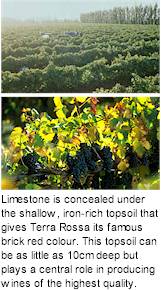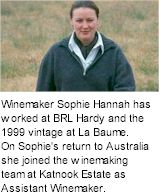


Jamiesons Run, based in the heart of the famous Coonawarra region was named as a tribute to it's pioneering past. Two men separated by time and distance laid the foundations for Jamiesons Run's creation. The first was Alfred Deakin, Australia's second prime minister with the assistance of Canadian irrigation experts William and George Chaffey and the second was John Riddoch.

John Riddoch, a Scottish migrant, established the Coonawarra Fruit Colony and planted the first vines in the Coonawarra area in 1890. The Undoolya Block vineyard contains hundred-year-old vines that date back from Riddoch's time, and is located close to where the Jamiesons Run winery is today.
Riddoch discovered the region's brick red coloured soil that was to become known as Terra Rossa - Australia's most famous wine-growing soil. Jamiesons Run's connection with Coonawarra started in 1953 as Mildara Wines under the guidance of director Ron Haselgrove, who purchased what turned out to be some of the most sought after parcels of Terra Rossa soil in Coonawarra.
Winemakers all over the world agree that "great wine is grown in the vineyard" - but to grow great wine you first need great soil. The international fame of Coonawarra is built on Australia's most prized wine growing soil, Terra Rossa. Coupled with a cooler maritime climate that ensures maximum flavour complexity, Terra Rossa (meaning 'Red Land') has made Coonawarra a winemaking paradise.

Although the Terra Rossa strip is only a few feet higher than neighbouring soils it has better drainage as a result. Vines dislike having 'wet feet' as this hampers their root development. Wet soil also means cold soil and it is a vital part of the Coonawarra phenomenon that, despite its cooler climate, grapes here repeatedly reach optimum ripeness. It is the warmth of the Terra Rossa soils that allow this consistency. An ideal mineral profile and low nitrogen content are also vital for taming the natural vigour of vines and producing low yields of highly flavoured fruit.
The Jamiesons Run core range consists of the original Coonawarra Cabernet Shiraz Merlot and four siblings. The Chardonnay has luscious stonefruit and creamy oak characters. The Coonawarra Merlot is a seductive wine with violets and red berries on the nose and palate. The Cabernet Sauvignon is an elegant and rich cabernet with sweet dark plum, mulberry and blueberry fruit flavours while the Shiraz displays ripe blackberry and dark cherry with subtle hints of spice giving the wine lift and grace. The Coonawarra Cabernet Shiraz Merlot is a classic expression of one of the world's great red winegrowing regions.
They all have a passion for the Coonawarra and strive to develop Jamiesons Run wines that display the finest characters from the region.

























